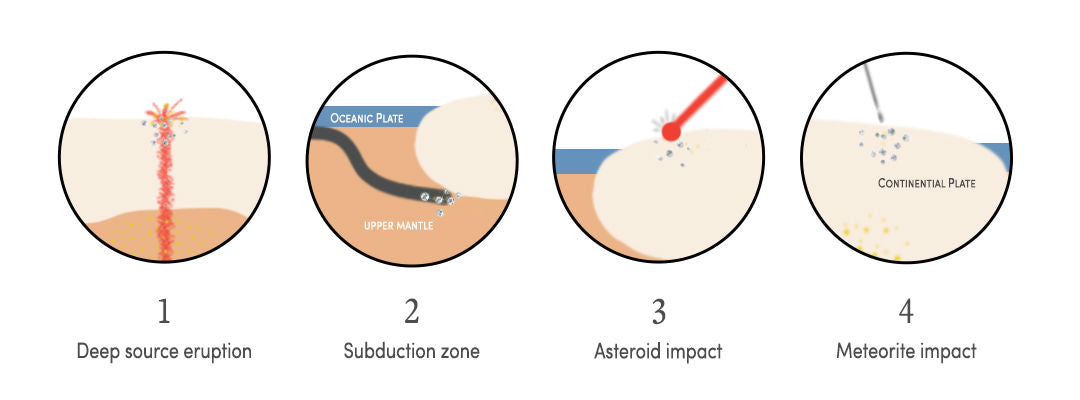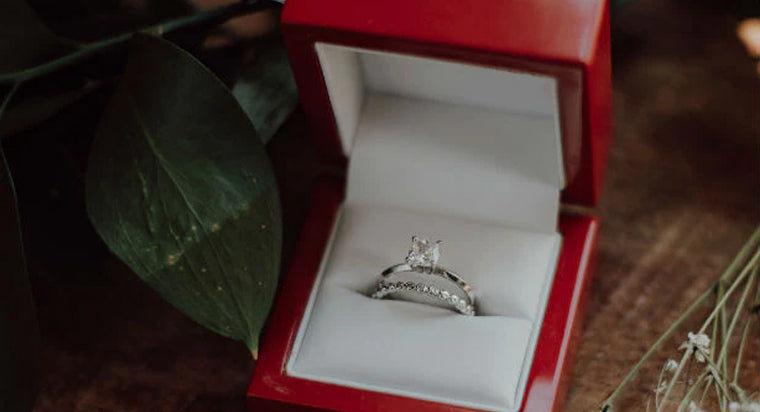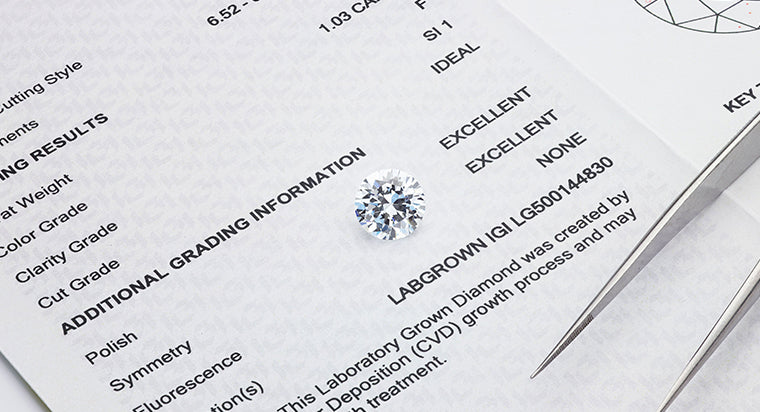Top 10 Most Frequently Asked Diamond Questions

Buying the right diamond starts with asking (and answering) the right questions. By assessing these questions and topics below, you'll be well positioned to tackle the diamond buying experience like a professional. If you can't answer these questions, you may want to do more research to ensure you make the right, confident purchasing decision. There's nothing worse than second guessing your decision and questioning whether you've made the right or wrong decision. You want to do this once so make sure you get it right!
TABLE OF CONTENTS
1. How to Tell if a Diamond is Real? Should the Diamond be Certified?
The best way to tell if a diamond is real is by consulting an expert gemologist with professional tools, or by requesting the diamond certificate. Our advice is that a diamond should absolutely be certified from a reputable institute. Buying non certified is almost a jeweler's "trick." Ensure you receive what you've paid for!
To evaluation if a diamond is real at home, learn about these five popular tests: Sandpaper, Read-through, Sparkle, Water, and Heat.
2. How are Diamonds Made? Where are Diamonds Found?
Mined diamonds form deep in the Earth's mantle. The exact time it takes varies because some materialize in days, weeks or months. Others can take millions of years. Formed by intense heat and pressure, diamonds are then delivered to the Earth's surface by deep-source volcanic eruptions or the movement of subduction zones that bring the diamonds up to the ocean floor. Fun fact! Diamonds can also be formed from the immense heat and pressure of asteroid strikes.

3. What are Diamonds Made of?
One might say coal that has been subjected to high temperature and pressure. This is false!
Chemically and physically, diamonds that are mined or manufactured are the same. For over a century, the technology of growing these gemstones has been experimented with but has recently just been perfected. Creating lab-made diamond versions in a modern lab using advanced technology lets us get products that are superior in quality to those that were mined in the Earth. Both mined/natural and lab grown diamonds are made of the element carbon, and are considered the hardest substances known to man.
4. What are the 4 C's and Which C is Most Important?
The infamous 4 C's of diamonds... Cut, Color, Clarity and Carat. Each of these characteristics defines the quality, size and sparkle of the diamond. They are the characteristics that affect the diamond's visual appearance and light performance (sparkle). Cut is the faceting, angles and proportions that are the pure light sparkle of the diamond. Color is actually the whiteness of the diamond, the less the better. Clarity is the size and position of microscopic imperfections in the diamond. And Carat is a reflection of the weight (and size) of the diamond. Because carat is the most visual C - it doesn't require a gemologist's eye to see which diamond is smaller or larger - it is the most popular. That's often why women (and men) want bigger. Bigger doesn't always mean more beautiful, but we can almost guarantee that the larger the diamond, the more likely it is to catch someone's eye. There's an important balance to strike though.
5. How much is a Diamond Worth? Maximize Your Diamond Purchase Value?
Value really comes from balancing the diamond's attributes, or (as mentioned above) the 4 C's. The best way to balance the 4 C's is consider carat on one side and cut, color and clarity on the other. As one goes up, the other may need to come down. As you calibrate these factors, you'll narrow diamond options as they come into your price range. That will find you a sweet spot. The average carat is about 0.70ct - 1.00ct with a G or H color with a VS2 or SI1 clarity and an Excellent cut.
6. How do You Choose a Diamond Budget?
Diamond budgeting can be one of the most difficult aspects of the entire process. Don't go by the rumors you hear about 2-3 months salary. Diamonds and rings are merely a symbolic commitment and a piece of jewelry. You'll want to ensure you have not spent beyond your means and that you're satisfied with the amount you're spending. Making personal, financial or other livelihood sacrifices for a diamond ring is the wrong approach. The average ring in the US retails for about $5,000. With that said, we've seen $2,000 rings that are stunning and look like $5,000 rings! Lucky for you, we've created a detailed diamond budgeting and pricing guide.
7. What Shape Should I Choose?
Round brilliant cuts are overwhelmingly the most popular shape, followed by princess cut diamonds. Rounds are the classic, traditional cut that are most desired since this is typically the first large jewelry purchase. Also, because tradition is deep rooted in the concepts of marriage. The round sparkles well, hides color/inclusions and looks larger than most of the fancy shape diamonds due to lower depth percentage. Keep in mind that it carries a premium for this reason as well. If you soon to be fiance isn't the traditional type, break away and go for a cushion cut or oval cut. These are not too farfetched and very popular. If you really want to be "out there," then explore marquise or pear shaped diamonds.
8. How do You Know if the Diamond is Conflict Free?
This really comes down to inquiring about your specific diamond and trusting your jeweler. You should always ask your jewelry to provide information about the origin of the diamond. While this can often be difficult to determine, if the jeweler is truly working with the diamond manufacturer/cutter, he or she will will to find out that information. Ensure the diamond comes from Botswana, Russia, Canada, Australia or a non conflict nation. Less than 0.1% of all gem quality diamonds in circulation are potentially related to conflicts. You probably have higher chances of conflict minerals in your cell phone than in your diamond ring. However, it's always better to be safe and have the peace of mind that your big moment isn't tainted.
9. Should I Buy In-Store or Online?
This is a personal question. Like with electronics, in today's day and age, we recommend the try in store, buy online methodology. The store can be valuable in helping you understand just how small inclusions are or how small the difference in color grades really is. However, the store will have higher prices, up to 30% more. There will be limitations in diamond selection and the sales pressure is much higher. Buying online saves you money, allows you to buy comfortably and gives you the widest range of options.
10. What if You Don't Love the Diamond? Should I Insure the Diamond?
Always, always, always understand the jeweler's return policy. You are making a huge commitment here and you shouldn't be stuck with a purchase is case it wasn't the perfect one. A reputable jeweler should offer some period of free return. That includes free shipping and no restocking fees. Jeweler's that don't allow returns or have fees for returns aren't confident in their product and it is an indication of the customer service experience you should expect in the future.
The biggest mistake post-purchase is forgetting/wanting to insure the diamond. We've heard too many horror stories of the diamond falling out (wear and tear or poor craftsmanship) or the ring being lost or stolen. Apart from an emotional loss, it can be a major financial setback to replace. And once you've given a ring, you can almost guarantee you'll be tasked with replacing it. At that time, you'll be glad you had insurance. Insurance can be provided by a specialized jewelry insurer or even the company that provides your renters or homeowners insurance.
Extra Question: How do I Clean the Diamond?
Diamonds are dirt and oil magnets. And dirt, oil and dust destroy a diamond's ability to sparkle because light cannot pass in and out. Every so often, possibly once a month, we recommend simply cleaning the diamond with a soft bristled toothbrush and soap with warm water. It's just that simple. It will restore the luster and shine of the diamond and look also as good as now. Once a year, request your jeweler to clean the diamond and ring. Their ultrasonic cleaner will be the most effective.
FAQs
Should I buy a certified diamond?
How are natural diamonds made?
What are the 4Cs of a diamond?
What diamond shape should I choose?
Should I buy a diamond in-store or online?







